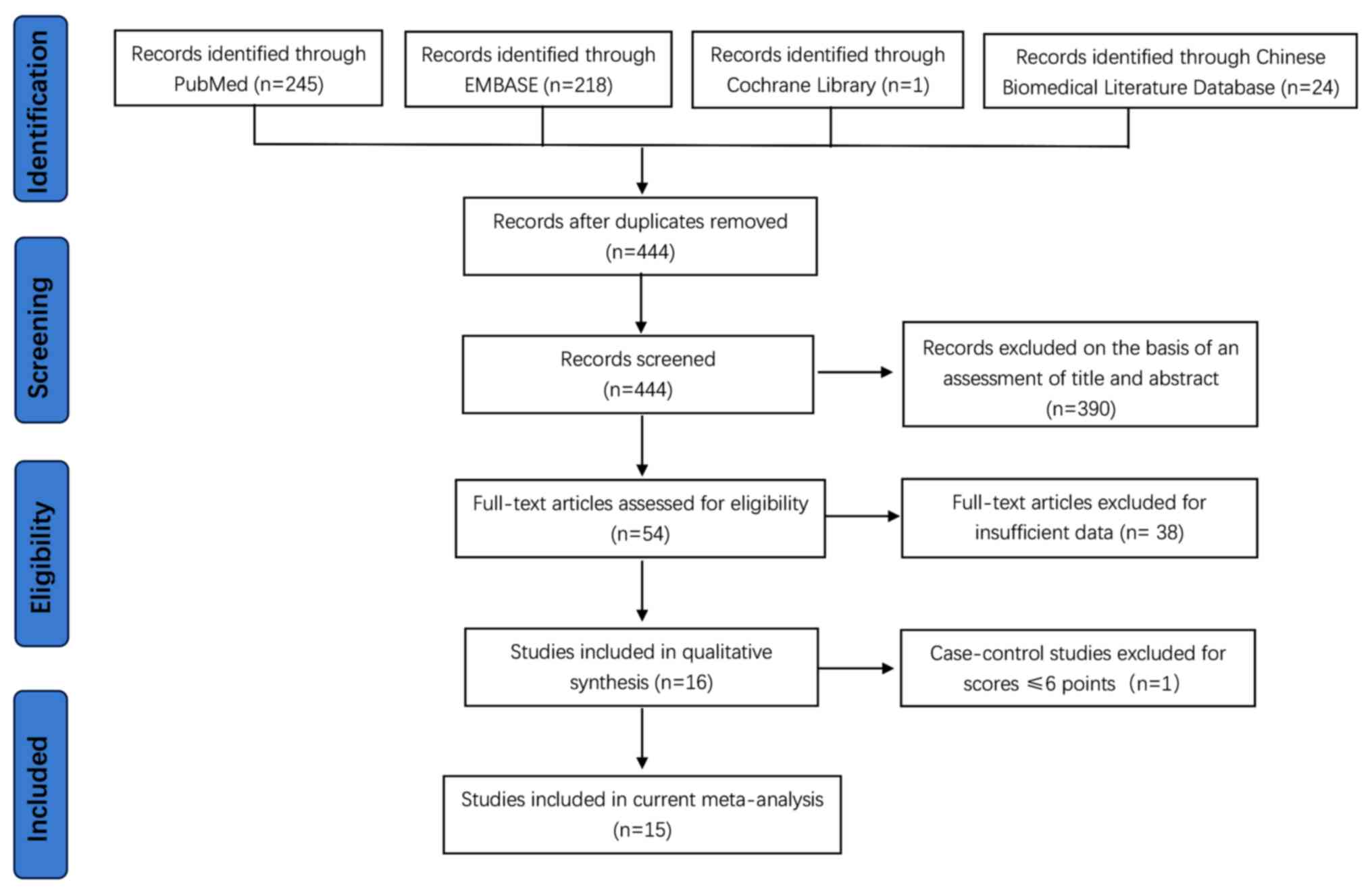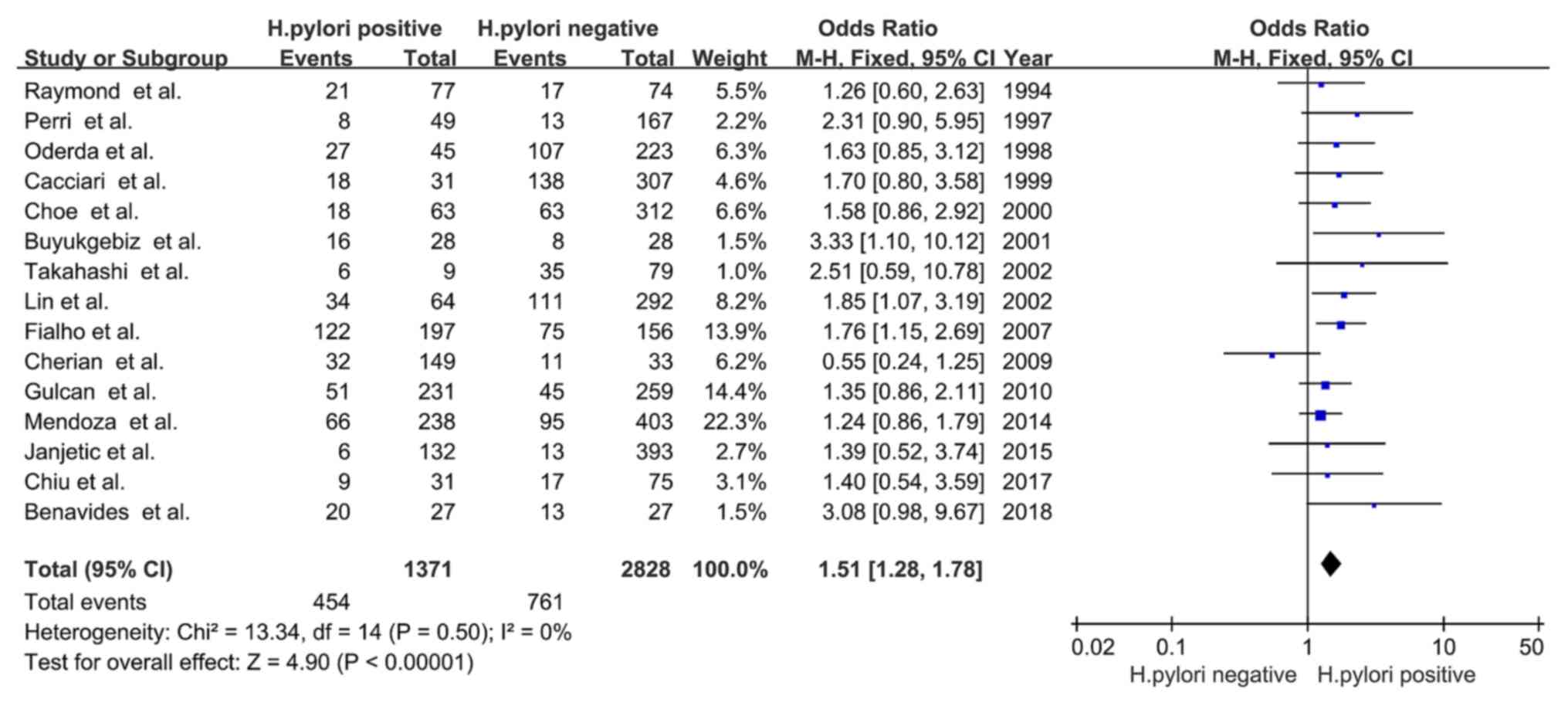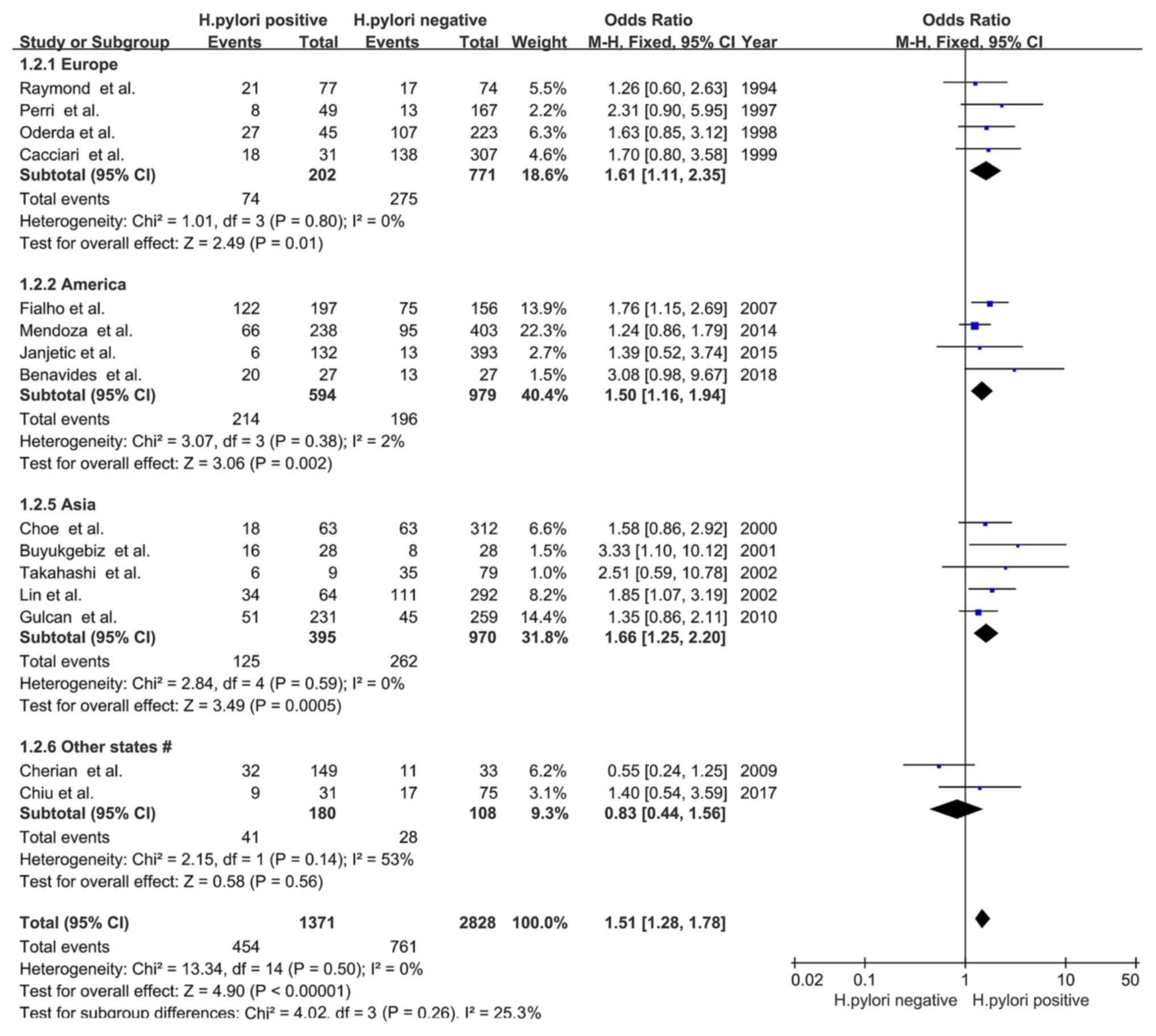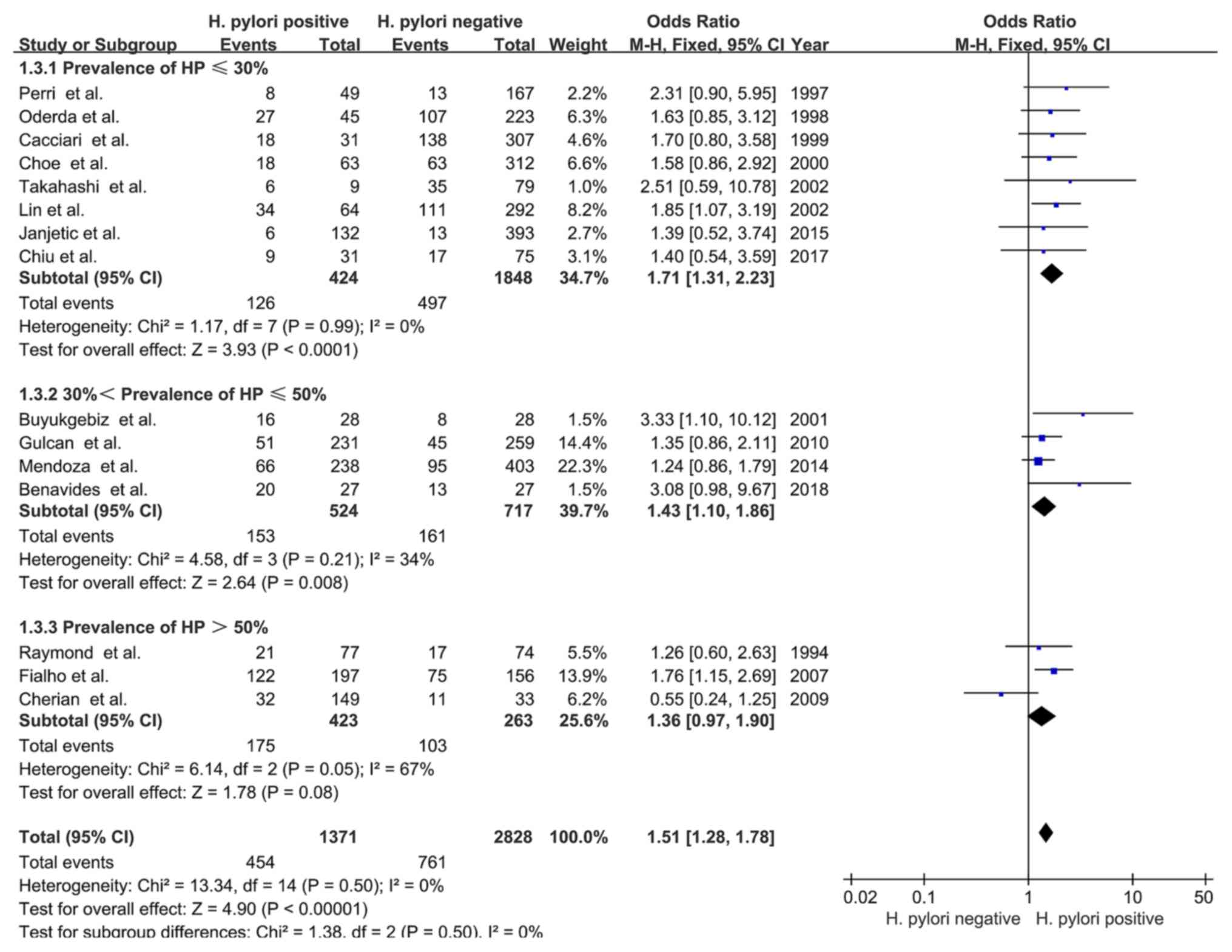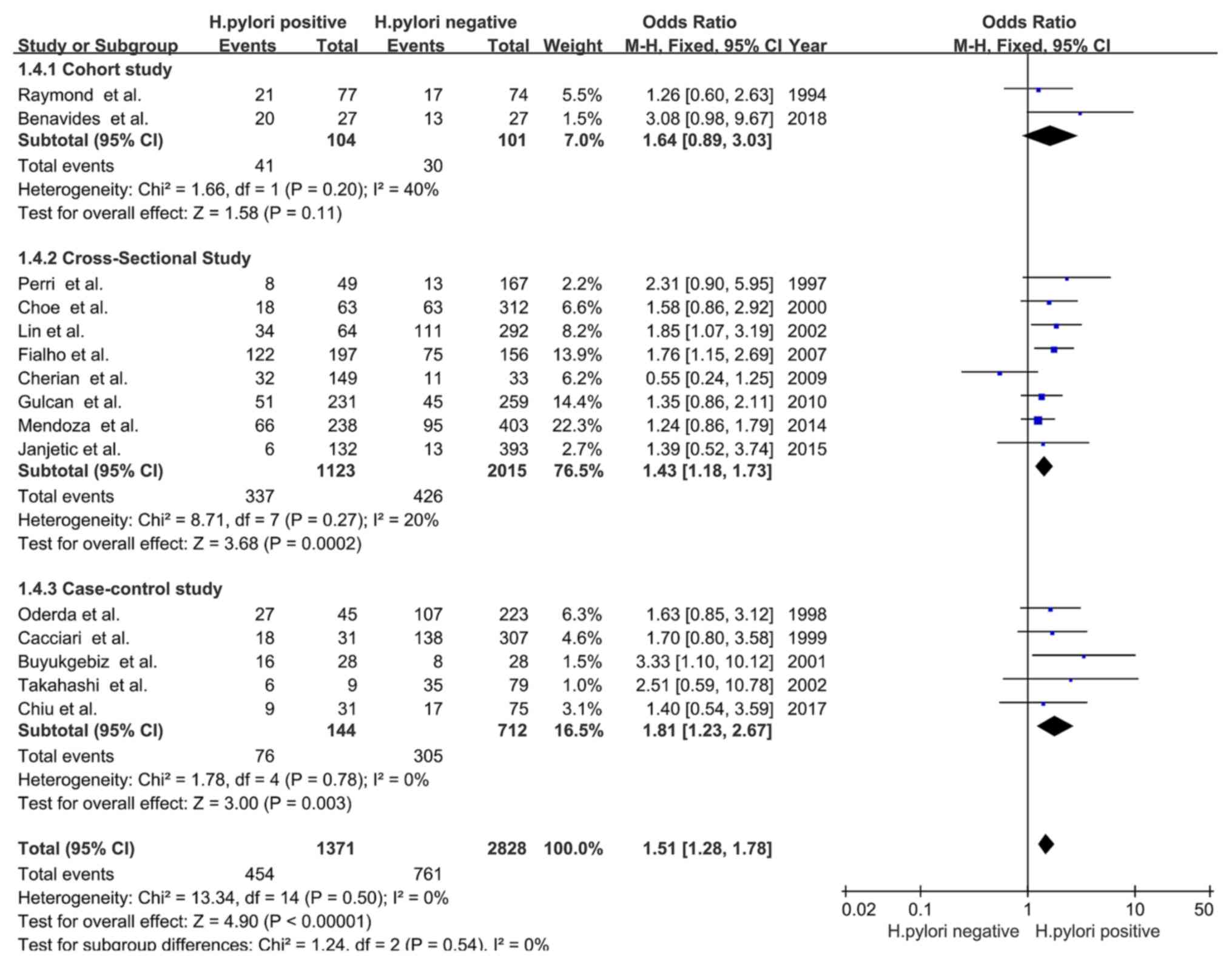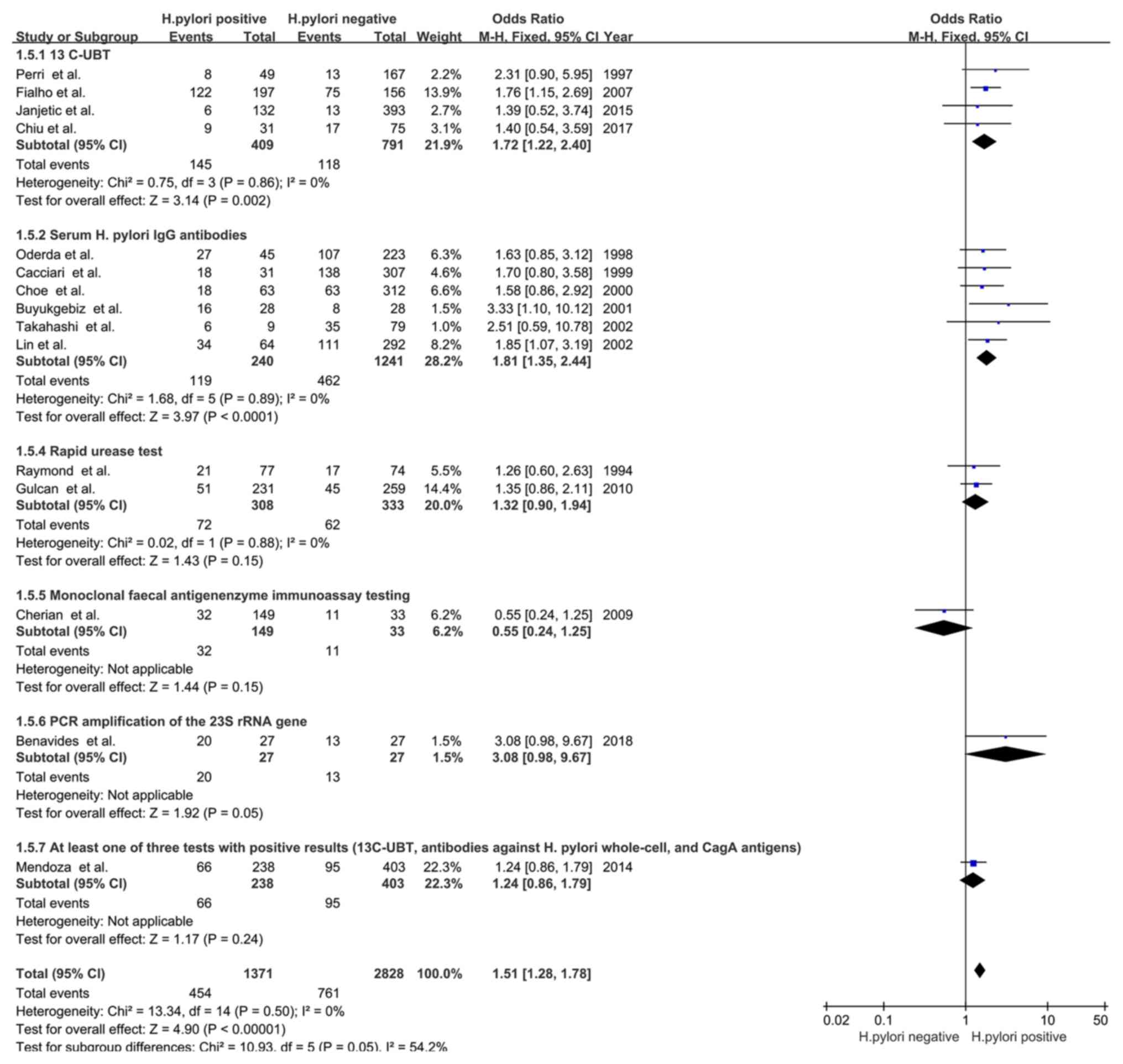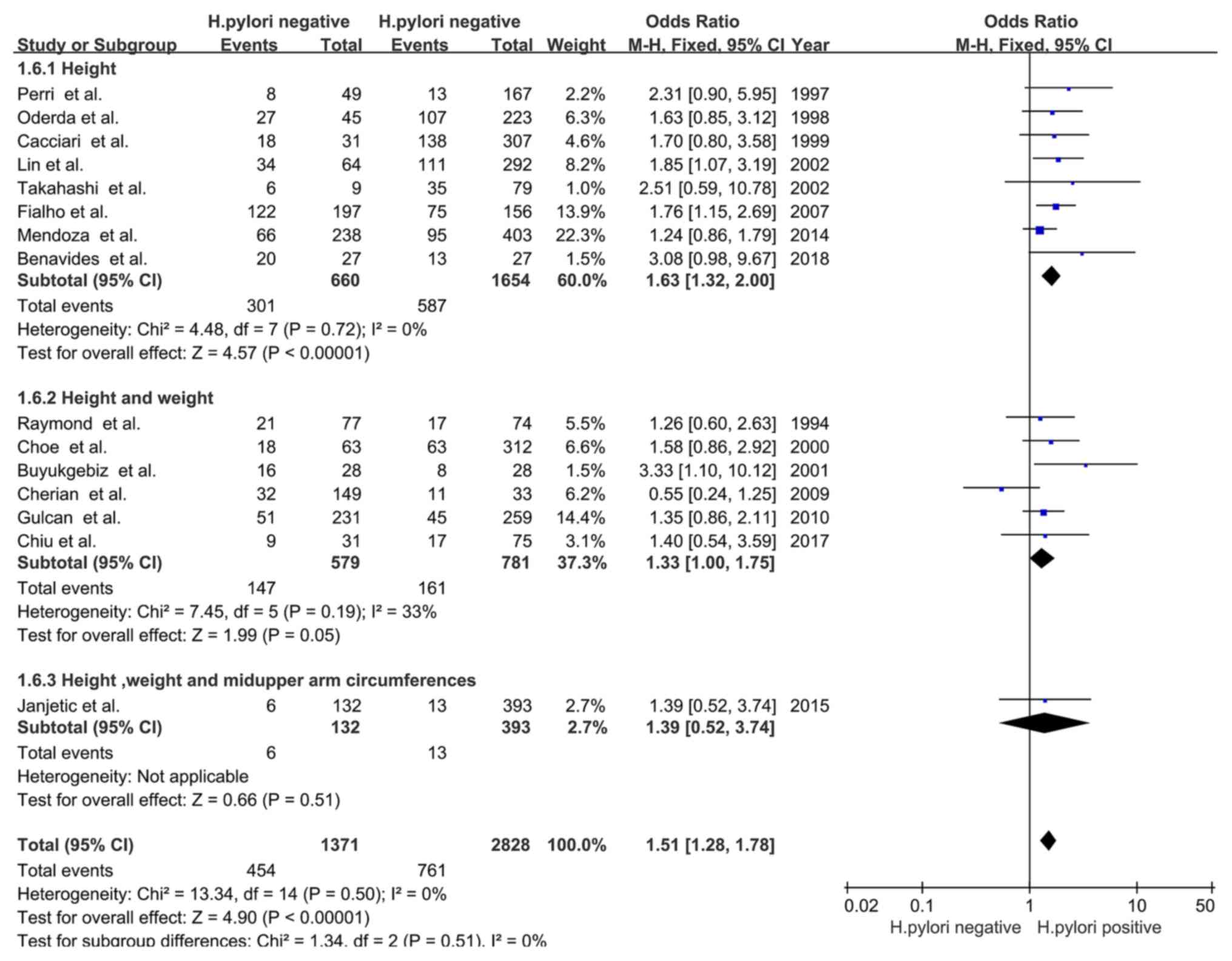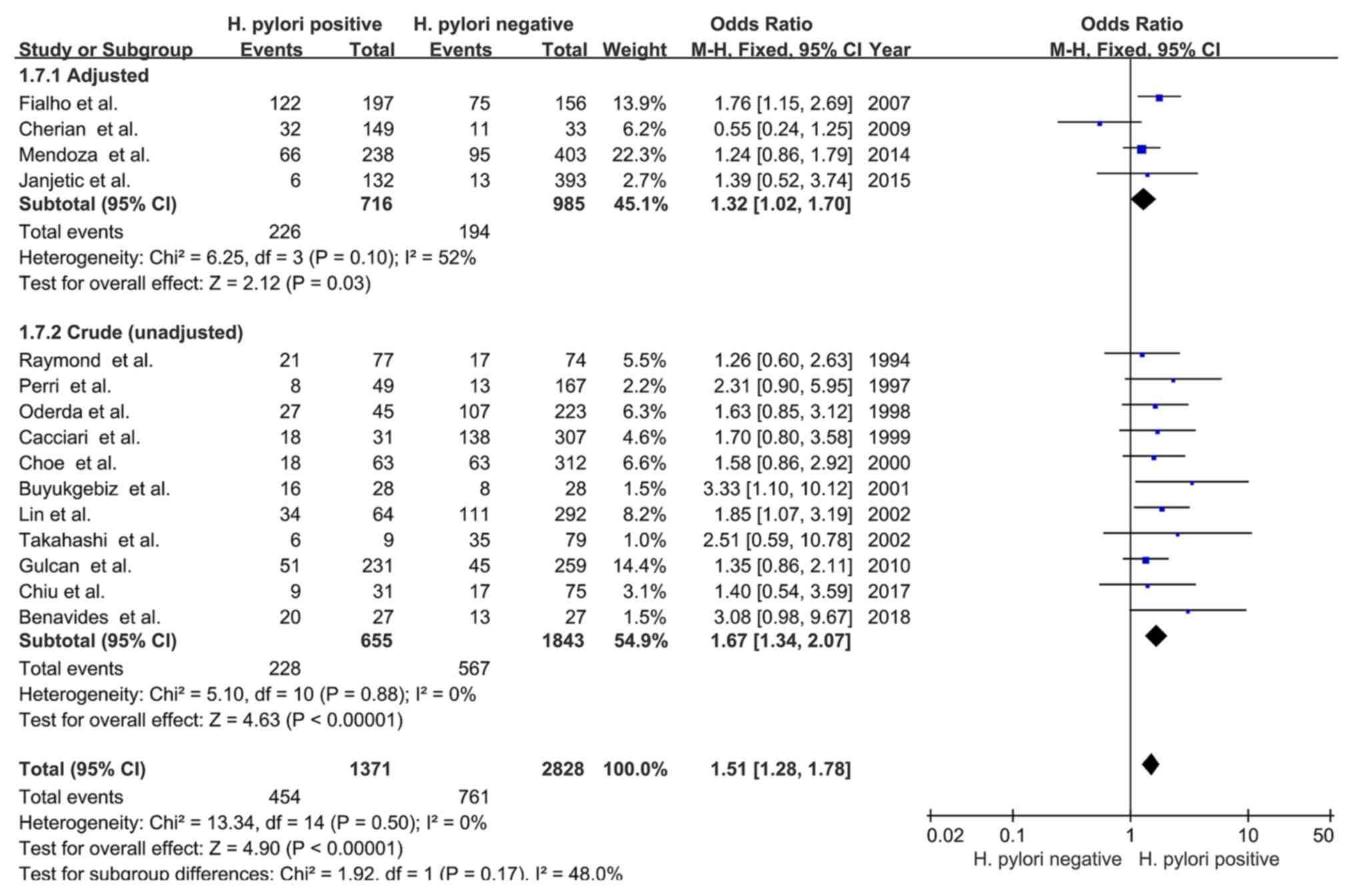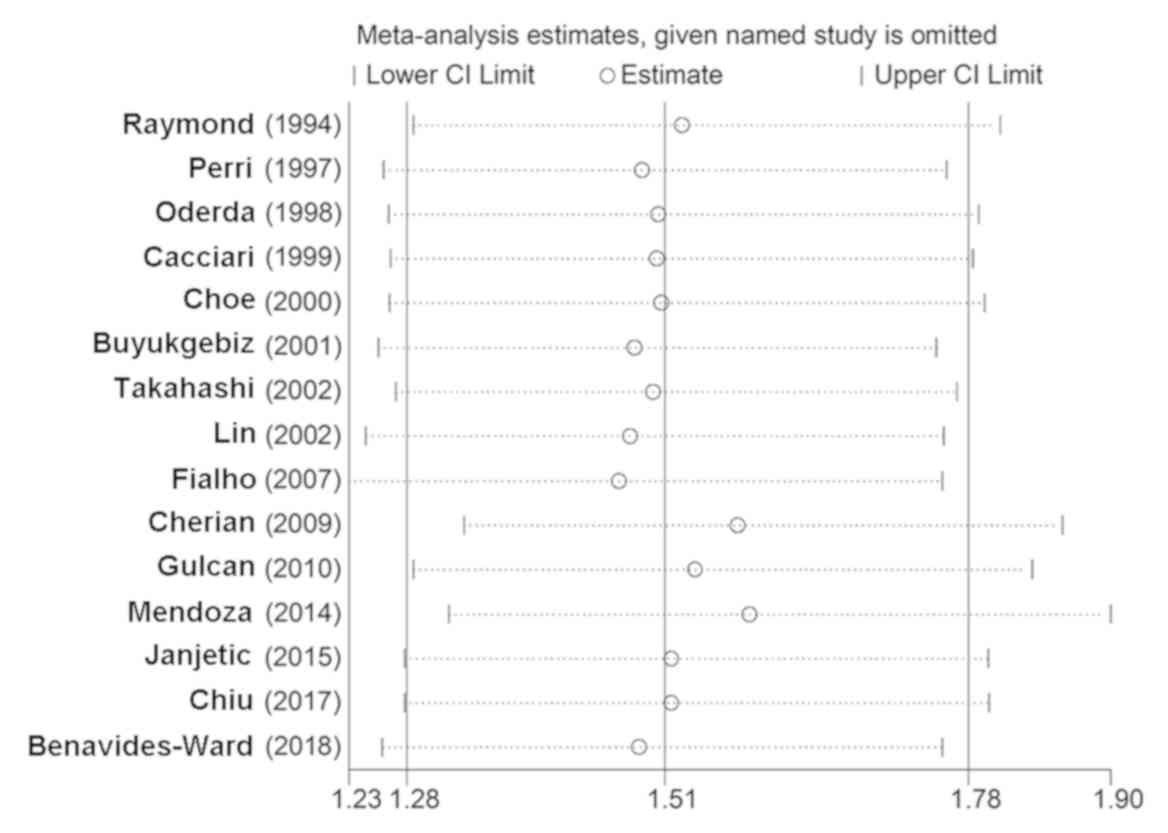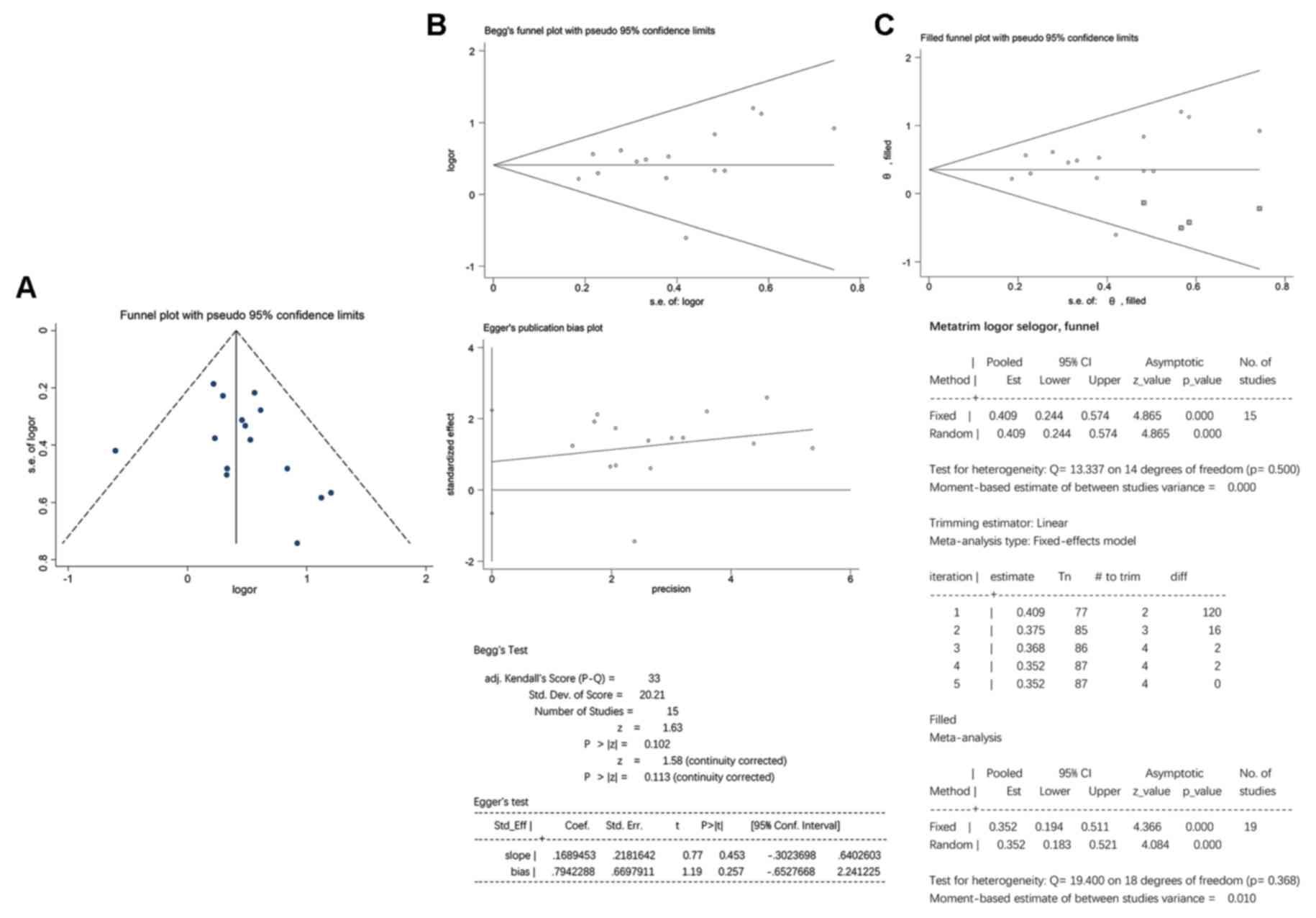|
1
|
Khalifa MM, Sharaf RR and Aziz RK:
Helicobacter pylori: A poor man's gut pathogen? Gut
Pathog. 2(2)2010.PubMed/NCBI View Article : Google Scholar
|
|
2
|
Engstrand L and Lindberg M:
Helicobacter pylori and the gastric microbiota. Best Pract
Res Clin Gastroenterol. 27:39–45. 2013.PubMed/NCBI View Article : Google Scholar
|
|
3
|
Plummer M, Franceschi S, Vignat J, Forman
D and de Martel C: Global burden of gastric cancer attributable to
Helicobacter pylori. Int J Cancer. 136:487–490.
2015.PubMed/NCBI View Article : Google Scholar
|
|
4
|
Ford AC, Gurusamy KS, Delaney B, Forman D
and Moayyedi P: Eradication therapy for peptic ulcer disease in
Helicobacter pylori-positive people. Cochrane Database Syst
Rev. 4(CD003840)2016.PubMed/NCBI View Article : Google Scholar
|
|
5
|
Yamaoka Y: Mechanisms of disease:
Helicobacter pylori virulence factors. Nat Rev Gastroenterol
Hepatol. 7:629–641. 2010.PubMed/NCBI View Article : Google Scholar
|
|
6
|
Hudak L, Jaraisy A, Haj S and Muhsen K: An
updated systematic review and meta-analysis on the association
between Helicobacter pylori infection and iron deficiency
anemia. Helicobacter. 22:2017.PubMed/NCBI View Article : Google Scholar
|
|
7
|
Kalach N, Bontems P, Koletzko S,
Mourad-Baars P, Shcherbakov P, Celinska-Cedro D, Iwanczak B,
Gottrand F, Martinez-Gomez MJ, Pehlivanoglu E, et al: Frequency and
risk factors of gastric and duodenal ulcers or erosions in
children: A prospective 1-month European multicenter study. Eur J
Gastroenterol Hepatol. 22:1174–1181. 2010.PubMed/NCBI View Article : Google Scholar
|
|
8
|
Bontems P, Kalach N, Vanderpas J, Iwanczak
B, Casswall T, Koletzko S, Oderda G, Martinez-Gomez MJ, Urruzuno P,
Kindermann A, et al: Helicobacter pylori infection in
European children with gastro-duodenal ulcers and erosions. Pediatr
Infect Dis J. 32:1324–1329. 2013.PubMed/NCBI View Article : Google Scholar
|
|
9
|
McColl KE and el-Omar E: Helicobacter
pylori and disturbance of gastric function associated with
duodenal ulcer disease and gastric cancer. Scand J Gastroenterol
Suppl. 215:32–37. 1996.PubMed/NCBI View Article : Google Scholar
|
|
10
|
Dror G and Muhsen K: Helicobacter
pylori infection and children's growth: An overview. J Pediatr
Gastroenterol Nutr. 62:e48–e59. 2016.
|
|
11
|
Yang YJ, Sheu BS, Yang HB, Lu CC and
Chuang CC: Eradication of Helicobacter pylori increases
childhood growth and serum acylated ghrelin levels. World J
Gastroenterol. 18:2674–2681. 2012.PubMed/NCBI View Article : Google Scholar
|
|
12
|
Jones NL, Koletzko S, Goodman K, Bontems
P, Cadranel S, Casswall T, Czinn S, Gold BD, Guarner J, Elitsur Y,
et al: Joint ESPGHAN/NASPGHAN guidelines for the management of
Helicobacter pylori in children and adolescents (Update
2016). J Pediatr Gastroenterol Nutr. 64:991–1003. 2017.PubMed/NCBI View Article : Google Scholar
|
|
13
|
Silva GM, Silva HM, Nascimento J,
Goncalves JP, Pereira F and Lima R: Helicobacter pylori
antimicrobial resistance in a pediatric population. Helicobacter.
23(e12528)2018.PubMed/NCBI View Article : Google Scholar
|
|
14
|
Velin D, Straubinger K and Gerhard M:
Inflammation, immunity, and vaccines for Helicobacter pylori
infection. Helicobacter. 21 (Suppl 1):S26–S29. 2016.PubMed/NCBI View Article : Google Scholar
|
|
15
|
Okuda M, Nomura K, Kato M, Lin Y, Mabe K,
Miyamoto R, Okumura A and Kikuchi S: Gastric cancer in children and
adolescents in Japan. Pediatr Int. 61:80–86. 2019.PubMed/NCBI View Article : Google Scholar
|
|
16
|
WHO Multicentre Growth Reference Study
Group: WHO child growth standards based on length/height, weight
and age. Acta Paediatr Suppl 450: 76.85, 2006.
|
|
17
|
de Onis M, Onyango AW, Borghi E, Siyam A,
Nishida C and Siekmann J: Development of a WHO growth reference for
school-aged children and adolescents. Bull World Health Organ.
85:660–667. 2007.PubMed/NCBI View Article : Google Scholar
|
|
18
|
Benavides-Ward A, Vasquez-Achaya F,
Silva-Caso W, Aguilar-Luis MA, Mazulis F, Urteaga N and Del
Valle-Mendoza J: Helicobacter pylori and its relationship with
variations of gut microbiota in asymptomatic children between 6 and
12 years. BMC Res Notes. 11(468)2018.PubMed/NCBI View Article : Google Scholar
|
|
19
|
Thomas JE, Dale A, Bunn JE, Harding M,
Coward WA, Cole TJ and Weaver LT: Early Helicobacter pylori
colonisation: The association with growth faltering in The Gambia.
Arch Dis Child. 89:1149–1154. 2004.PubMed/NCBI View Article : Google Scholar
|
|
20
|
Perri F, Pastore M, Leandro G, Clemente R,
Ghoos Y, Peeters M, Annese V, Quitadamo M, Latiano A, Rutgeerts P
and Andriulli A: Helicobacter pylori infection and growth
delay in older children. Arch Dis Child. 77:46–49. 1997.
|
|
21
|
Fialho AM, Braga AB, Queiroz DM, Rodrigues
MN, Herbster ID and Braga LL: The association between
Helicobacter pylori infection and height in children from an
urban community in north-east Brazil. Ann Trop Paediatr. 27:55–61.
2007.PubMed/NCBI View Article : Google Scholar
|
|
22
|
Patel P, Mendall MA, Khulusi S, Northfield
TC and Strachan DP: Helicobacter pylori infection in
childhood: Risk factors and effect on growth. BMJ. 309:1119–1123.
1994.PubMed/NCBI View Article : Google Scholar
|
|
23
|
Taşar A, Kibrisli E and Dallar Y:
Seroprevalence of Helicobacter pylori in children with
constitutional height retardation. Turk J Gastroenterol. 17:7–12.
2006.PubMed/NCBI
|
|
24
|
Liu WZ, Xie Y, Lu H, Cheng H, Zeng ZR,
Zhou LY, Chen Y, Wang JB, Du YQ, Lu NH, et al: Fifth Chinese
national consensus report on the management of Helicobacter pylori
infection. Helicobacter. 23(e12475)2018.PubMed/NCBI View Article : Google Scholar
|
|
25
|
Bunn JE, Thomas JE, Harding M, Coward WA
and Weaver LT: Placental acquisition of maternal specific IgG and
Helicobacter pylori colonization in infancy. Helicobacter.
8:568–572. 2003.PubMed/NCBI View Article : Google Scholar
|
|
26
|
Stroup DF, Berlin JA, Morton SC, Olkin I,
Williamson GD, Rennie D, Moher D, Becker BJ, Sipe TA and Thacker
SB: Meta-analysis of observational studies in epidemiology: A
proposal for reporting. Meta-analysis of observational studies in
epidemiology (MOOSE) group. JAMA. 283:2008–2012. 2000.PubMed/NCBI View Article : Google Scholar
|
|
27
|
Moher D, Liberati A, Tetzlaff J and Altman
DG: PRISMA Group: Preferred reporting items for systematic reviews
and meta-analyses: The PRISMA statement. Int J Surg. 8:336–341.
2010.PubMed/NCBI View Article : Google Scholar
|
|
28
|
Stang A: Critical evaluation of the
Newcastle-Ottawa scale for the assessment of the quality of
nonrandomized studies in meta-analyses. Eur J Epidemiol.
25:603–605. 2010.PubMed/NCBI View Article : Google Scholar
|
|
29
|
Hu J, Dong Y, Chen X, Liu Y, Ma D, Liu X,
Zheng R, Mao X, Chen T and He W: Prevalence of suicide attempts
among Chinese adolescents: A meta-analysis of cross-sectional
studies. Compr Psychiatry. 61:78–89. 2015.PubMed/NCBI View Article : Google Scholar
|
|
30
|
Higgins JP, Thompson SG, Deeks JJ and
Altman DG: Measuring inconsistency in meta-analyses. BMJ.
327:557–560. 2003.PubMed/NCBI View Article : Google Scholar
|
|
31
|
Belachew A and Tewabe T: Neonatal sepsis
and its association with birth weight and gestational age among
admitted neonates in Ethiopia: Systematic review and meta-analysis.
BMC Pediatr. 20(55)2020.PubMed/NCBI View Article : Google Scholar
|
|
32
|
Raymond J, Bergeret M, Benhamou PH, Mensah
K and Dupont C: A 2-year study of Helicobacter pylori in
children. J Clin Microbiol. 32:461–463. 1994.PubMed/NCBI
|
|
33
|
Choe YH, Kim SK and Hong YC:
Helicobacter pylori infection with iron deficiency anaemia
and subnormal growth at puberty. Arch Dis Child. 82:136–140.
2000.PubMed/NCBI View Article : Google Scholar
|
|
34
|
Lin X: Study on risk factors of
Helicobacter pylori infection and the effect of Helicobacter
pylori infection on iron status and growth among preschool
children (vol. Master). Fujian Med Univ. pp65:2002.
|
|
35
|
Cherian S, Forbes D, Sanfilippo F, Cook A
and Burgner D: Helicobacter pylori, helminth infections and
growth: A cross-sectional study in a high prevalence population.
Acta Paediatr. 98:860–864. 2009.PubMed/NCBI View Article : Google Scholar
|
|
36
|
Gulcan M, Ozen A, Karatepe HO, Gulcu D and
Vitrinel A: Impact of H. pylori on growth: Is the infection
or mucosal disease related to growth impairment? Dig Dis Sci.
55:2878–2886. 2010.
|
|
37
|
Mendoza E, Camorlinga-Ponce M, Perez-Perez
G, Mera R, Vilchis J, Moran S, Rivera O, Coria R, Torres J, Correa
P and Duque X: Present and past Helicobacter pylori
infection in Mexican school children. Helicobacter. 19:55–64.
2014.PubMed/NCBI View Article : Google Scholar
|
|
38
|
Janjetic MA, Mantero P, Cueto RE, Balcarce
N, Zerbetto de Palma G, Catalano M, Zubillaga MB, Boccio JR and
Goldman CG: Dietary and anthropometric indicators of nutritional
status in relation to Helicobacter pylori infection in a
paediatric population. Br J Nutr. 113:1113–1119. 2015.PubMed/NCBI View Article : Google Scholar
|
|
39
|
Oderda G, Palli D, Saieva C, Chiorboli E
and Bona G: Short stature and Helicobacter pylori infection
in italian children: Prospective multicentre hospital based
case-control study. The Italian study group on short stature and
H. pylori. BMJ. 317:514–515. 1998.PubMed/NCBI View Article : Google Scholar
|
|
40
|
Cacciari E, Menegatti M, Salardi S, Ali A,
Stella FA, Figura N, Landi F, Holton J, Farinelli S, Cuccaro V, et
al: Helicobacter pylori infection and cytotoxic antigen
associated gene ‘A’ status in short children. J Pediatr Endocrinol
Metab. 12:197–201. 1999.
|
|
41
|
Büyükgebiz A, Dündar B, Böber E and
Büyükgebiz B: Helicobacter pylori infection in children with
constitutional delay of growth and puberty. J Pediatr Endocrinol
Metab. 14:549–551. 2001.PubMed/NCBI View Article : Google Scholar
|
|
42
|
Takahashi M, Kimura H and Watanabe K:
Helicobacter pylori infection in patients with idiopathic
short stature. Pediatr Int. 44:277–280. 2002.PubMed/NCBI View Article : Google Scholar
|
|
43
|
Chiu NC, Lin CY, Chi H, Yeung CY, Ting WH,
Chan WT, Jiang CB, Li ST, Lin CH and Lee HC: Helicobacter
pylori infection is not associated with failure to thrive: A
case control study. Ther Clin Risk Manag. 13:273–278.
2017.PubMed/NCBI View Article : Google Scholar
|
|
44
|
Chilengi R, Asombang M, Kadota JL,
Chilyabanyama ON, Mwila-Kazimbaya K, Ng'Ombe H, Simuyandi M and
Bosomprah S: Early linear growth retardation: Results of a
prospective study of Zambian infants. Bmc Public Health.
19(61)2019.PubMed/NCBI View Article : Google Scholar
|
|
45
|
Queiroz DM, Rocha AM and Crabtree JE:
Unintended consequences of Helicobacter pylori infection in
children in developing countries: Iron deficiency, diarrhea, and
growth retardation. Gut Microbes. 4:494–504. 2013.PubMed/NCBI View Article : Google Scholar
|
|
46
|
Ortiz-Princz D, Daoud G, Salgado-Sabel A
and Cavazza ME: Helicobacter pylori infection in children:
Should it be carefully assessed? Eur Rev Med Pharmacol Sci.
20:1798–1813. 2016.PubMed/NCBI
|
|
47
|
Wroblewski LE and Peek RJ Jr:
Helicobacter pylori in gastric carcinogenesis: Mechanisms.
Gastroenterol Clin North Am. 42:285–298. 2013.PubMed/NCBI View Article : Google Scholar
|
|
48
|
Serrano C, Wright SW, Bimczok D, Shaffer
CL, Cover TL, Venegas A, Salazar MG, Smythies LE, Harris PR and
Smith PD: Downregulated Th17 responses are associated with reduced
gastritis in Helicobacter pylori-infected children. Mucosal
Immunol. 6:950–959. 2013.PubMed/NCBI View Article : Google Scholar
|
|
49
|
Muhsen K, Ornoy A, Akawi A, Alpert G and
Cohen D: An association between Helicobacter pylori
infection and cognitive function in children at early school age: A
community-based study. BMC Pediatr. 11(43)2011.PubMed/NCBI View Article : Google Scholar
|
|
50
|
Bazmamoun H, Rafeey M, Nikpouri M and
Ghergherehchi R: Helicobacter pylori infection in children
with type 1 diabetes mellitus: A case-control study. J Res Health
Sci. 16:68–71. 2016.PubMed/NCBI
|
|
51
|
Xiong LJ and Mao M: Current views of the
relationship between Helicobacter pylori and
Henoch-Schonlein purpura in children. World J Clin Pediatr.
5:82–88. 2016.PubMed/NCBI View Article : Google Scholar
|
|
52
|
Dehghani SM, Karamifar H, Raeesi T and
Haghighat M: Growth parameters in children with dyspepsia symptoms
and Helicobacter pylori infection. Indian Pediatr.
50:324–326. 2013.PubMed/NCBI View Article : Google Scholar
|
|
53
|
Asgeirsdottir GA, Kjartansdottir I,
Olafsdottir AS, Hreinsson JP, Hrafnkelsson H, Johannsson E and
Bjornsson ES: Helicobacter pylori infection in Icelandic
children. Scand J Gastroenterol. 52:686–690. 2017.PubMed/NCBI View Article : Google Scholar
|
|
54
|
Nakayama Y, Lin Y, Hongo M, Hidaka H and
Kikuchi S: Helicobacter pylori infection and its related
factors in junior high school students in Nagano Prefecture, Japan.
Helicobacter. 22:2017.PubMed/NCBI View Article : Google Scholar
|
|
55
|
Shu X, Ping M, Yin G and Jiang M:
Investigation of Helicobacter pylori infection among
symptomatic children in Hangzhou from 2007 to 2014: A retrospective
study with 12,796 cases. PeerJ. 5(e2937)2017.PubMed/NCBI View Article : Google Scholar
|
|
56
|
Awuku YA, Simpong DL, Alhassan IK, Tuoyire
DA, Afaa T and Adu P: Prevalence of helicobacter pylori infection
among children living in a rural setting in Sub-Saharan Africa. Bmc
Public Health. 17(360)2017.PubMed/NCBI View Article : Google Scholar
|
|
57
|
Koletzko S, Jones NL, Goodman KJ, Gold B,
Rowland M, Cadranel S, Chong S, Colletti RB, Casswall T, Elitsur Y,
et al: Evidence-based guidelines from ESPGHAN and NASPGHAN for
Helicobacter pylori infection in children. J Pediatr
Gastroenterol Nutr. 53:230–243. 2011.PubMed/NCBI View Article : Google Scholar
|
|
58
|
Ferwana M, Abdulmajeed I, Alhajiahmed A,
Madani W, Firwana B, Hasan R, Altayar O, Limburg PJ, Murad MH and
Knawy B: Accuracy of urea breath test in Helicobacter pylori
infection: Meta-analysis. World J Gastroenterol. 21:1305–1314.
2015.PubMed/NCBI View Article : Google Scholar
|
|
59
|
Leal YA, Flores LL, Fuentes-Pananá EM,
Cedillo-Rivera R and Torres J: 13C-urea breath test for the
diagnosis of Helicobacter pylori infection in children: A
systematic review and meta-analysis. Helicobacter. 16:327–337.
2011.PubMed/NCBI View Article : Google Scholar
|
|
60
|
Raj P, Thompson JF and Pan DH:
Helicobacter pylori serology testing is a useful diagnostic
screening tool for symptomatic inner city children. Acta Paediatr.
106:470–477. 2017.PubMed/NCBI View Article : Google Scholar
|
|
61
|
Seo JH, Lim CW, Park JS, Yeom JS, Lim JY,
Jun JS, Woo HO, Youn HS, Baik SC, Lee WK, et al: Correlations
between the CagA antigen and serum levels of anti-Helicobacter
pylori IgG and IgA in children. J Korean Med Sci. 31:417–422.
2016.PubMed/NCBI View Article : Google Scholar
|
|
62
|
Romano C, Valenti S, Cardile S and
Benninga MA: Functional dyspepsia: An enigma in a conundrum. J
Pediatr Gastroenterol Nutr. 63:579–584. 2016.PubMed/NCBI View Article : Google Scholar
|















